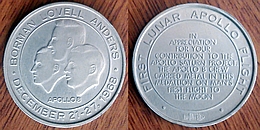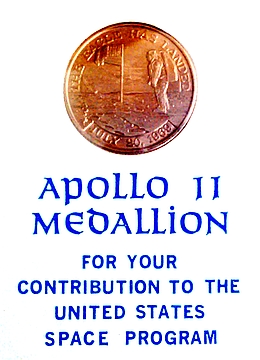„But, remember, our Alan Shepard was sent to space just one month after Yuri.“ Interview with Edward F. Ladenburger about his involvement in space engineering for the first astronauts and apollo program. (OTD in 1961, Alan Shepard made his flight with Freedom 7.)
Quelle: Sven Frerichs and Krischan Müller.
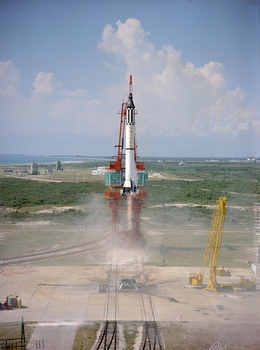
(Picture: NASA)
German language version / Version in Deutsch:
Sven Frerichs and Krischan Müller visited with their youth band their partnership-city of Schwieberdingen/Germany Belvidere/Illinois/USA in june 2017. As science interested musicians we had not to regret that we didn’t take a trip to Kennedy Space Center at our first USA-travel because we fortunately had the great oppurtunity to met Edward Ladenburger (and some crazy aviators) who could told us a lot of his career as space engineer in time of the apollo program.
Now Sven took the opportunity to start with Krischan an interview with Edward Ladenburger for his school project about Edwards involvements in space engineering. Because it was so interesting and we got a lot of informations so that we summarized our conversations with Edward for you or posterity:
Who are you and since when are you on earth?
Edward F. Ladenburger: Edward F. Ladenburger, Project Engineering Manager. I am 85 years old (at this interview). Born in 1932.
We know you were involved in space engineering. In which authority or companies had you worked and what was your job?
Edward F. Ladenburger: Direct all aspects of a project, from initial design, manufacture, qualification (integrity of material source and verification of chemical composition and function) tests, manufacturing, and integration into system operation, cleanliness of product and storage options. Later came manufacturing schedules. Of course, costs were very important, having the proper qualified personnel, and meeting schedules on time. Daily progress reports and many conferences in which there was a need to support the path chosen and corroborate the progress achieved.
The first Company I was employed at was „Hamilton Standard“, Division of „United Technologies Corporation“, in Windsor Locks, Connecticut. We had a contract from NASA to provide the porous-plate sublimator – for the space suit backpack and the Command Module and Lunar Excursion Module. This device provided a self controlled heat rejection system for the electronics, by which excess heat was „dumped“ overboard. This system played an integral part in saving after the service module oxygen tank ruptured and the crew was able to return safely using the Lunar Module. This period of work covered the Mercury, Gemini, and Apollo missions.
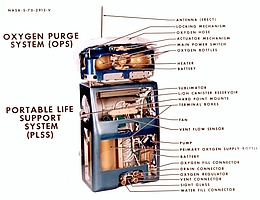
(Picture: NASA)
Later in my career I worked for Sundstrand in Rockford, Illinois. This work involved using hydrazine as a propellant in rocket clusters to help stabilize the trajectory of the main thrust rocket. In both companies, I was also deeply involved with both military and commercial aircraft. At one time I had equipment on all US military aircraft.
Was it your decision to make space engineering, how did you get there was the launch of Sputnik in October 4th 1957 a reason?
Edward F. Ladenburger: The Sputnik satellite was generally considered a manikin in a store window. Dressed up to show. An oversized rocket that pushed a beeping satellite to orbit the earth. Done primarily to show the world what they could do. It did serve probably as a „wake-up“ call for the US scientific community to pay closer attention and focus on the aim of putting a man on the moon. It was a technical purpose that intended to answer many scientific questions and to advance man’s knowledge of our surroundings. Sputnik was not an emphasis for me to engage in the space exploration program. I graduated from Virginia Polytechnic Institute and State University, where an earlier graduate had become the head of NASA Control Center in Houston. He frequently brought respected scientists, already involved in space and related research, to the school to give an explanation of their work. As a graduate engineer, I was searching for an engineering position that had promise of technical challenge, good working conditions, educated and state-of-the-art co-workers, advancement based on performance, good pay and a no-nonsense management ethic. Hamilton Standard made me an offer I couldn’t refuse. With early success, major responsibilities came quickly and the challenge of the space program got me.
The US space program has always been driven by a desire to investigate the unknown. Think of how many thousands of years man has gazed at the moon and stars and wondered of their beauty and origin, what they were composed of, whether there was any trace of life, whether the atmosphere was capable of supporting life as we know it, whether any moisture was present, etc, etc, etc. A thousand questions all clamored to be answered. This was the type challenge I saw in solving the problems to enable man to press forward toward long awaited answers, eventually I met all the original Astronauts as they came to our research/test laboratories to witness the equipment we were preparing for their use in space. Meeting them put a very personal touch on all the work we did, knowing that the slightest mistake could be disastrous for them.
Was it an honor to be involved in these projects?
Edward F. Ladenburger: Absolutey! The technical challenge was made by President John F. Kennedy, that we (the USA) was going to beat the USSR to the moon and in all aspects of space travel (quickly and safely). We considered the safety of our astronauts paramount. The USSR considered their people expendable. There are many verifiable instances of this attitude. I felt extremely honored to be considered worthy of participating in this engineering endeavor, and I spent many periods of 24 to 36 hours straight to keep on schedule and to assure things were proper. At that time my security clearance was top secret and was protected by close scrutiny.
Did they put pressure on you?
Edward F. Ladenburger: Yes, there was considerable pressure. But it was a combination of the significant engineering challenge, the desire to not make mistakes because the astronauts life was at risk, and the desire to not allow the USSR to become the leader in space. Obviously many scientists/engineers were working at various parts of the program, and the master schedule required each part arrive at precisely the porper time to meld with other parts to form the „whole“. If one part was out of sync, it would throw the entire program out of schedule. No one wanted to be the cause of a delay. We were moving quickly, but without losing the accuracy or forward thinking of the entire program. Most people felt the technical challenge of space travel, especially to the moon, was an advance in scientific knowledge that we wanted to be part of. Besides, in spite of the closed borders and secrecy of the USSR, we knew what was happening with their space program. They had „many“ failures, involving loss of life, that they wanted desperately to keep quiet. When they saw all the benefit of being (relatively) open and honest about progress in the USA, they for a short time opened their program to reporters. But, they wanted to have a success as in the USA. They brought their capsules down from space by means of a parachute. The kremlin demanded a flight to show the world they could be just as successful as the USA. The Russian engineers developing the chute design, said we are not ready. Moscow demanded the flight take place immediately. It did, but when time to return to earth, the chute didn’t open and the capsule plunged into the earth. The USSR immediately closed all borders again and allowed no further review of their program. We felt sorry for the Cosmonaut, sacrificed by bureaucracy.
As you heared that Yuri Gagarin is in space what were your feelings and thoughts? Were the motivation to keep on your mission still the same after the message? What was the different between USSR and USA firsts human spaceflights in 1961?
Edward F. Ladenburger: When Yuri Gagarin’s flight was announced, my feelings were that this was a fantastic accomplishment, the first human into outer space was considered a veritable success, regardless of who did it. But, remember, our Alan Shepard was sent to space just one month after Yuri Gagarin. So we did not grumble about being first because many of the features of the Russian program came directly from the designs created and tested in the USA. Sometimes the Russians had more spies lurking about our centers of research and test than we had engineers working on the projects. We had confidence that our efforts and attention to safety and ingenuity would win. Besides we knew (in spite of the USSR’s closed borders) just how far behind they were.
For science, it was a great accomplishment, man’s first journey into earth orbit. Of course I wished it had been from the USA, but, that didn’t detract from the accomplishment. Besides, I knew we were close behind, and had the impetus for much more. The paths to achieve space exploration, took different directions. The USSR tended to Muscle through problems because of their race to be first, whereas the USA was „forced“ into more finesse in the basic designs. Example: the USSR had extracted some of the great rocket scientists from Germany at the close of WWII and had huge rockets to muscle big payloads into space. They, therefore, didn’t have to pay as much attention to being weight conscience, (things like the air breathing environment for the cosmonauts), just take large quantities of air (bottled) as if on the earths surface. This was possible because of the great payload they had available. The US had rocketry with less payload, so moved in the direction of being very weight conscious. So, we used only that portion of the atmosphere that was essential for human sustanance. Forget the massive amount of nitrogen in earth atmosphere, only about 3.2 PSI of oxygen was essential for man’s survival. This meant much less payload, and was more amenable to long flights of human rated space travel.
So you met all original astronauts did you had the wish sometime to are allowed and able to fligh in space yourselves?
Edward F. Ladenburger: I was just coming aboard the program as Shepards first flight took place on May 1961. (Yuri made the first orbit on April 1961.) I did not have the urge to be a space traveler, particularly in the early stages of the program. It was probably a case of the more one knows of the dangers involved and intricacies of the designs and being aware that in spite of the overwhelming testing accomplished, there is always some hidden flaw or oversight that even the best of us cannot always forsee. So I give a great deal of credit and acknowledgement to those who have great fortitude and willingness to brave the unknown. At this point in time, earth orbit seems like a „piece of cake“. The next step is a „trip“ to Mars, which will probably be one way (no return). Yet there are many who are ready to sign-up for this adventure.
How do you experienced the moon landing and how do you feel about it?
Edward F. Ladenburger: Everything had to come together correctly for the moon landing to be successful. After all, this was a first. How long has man looked at the moon and wondered what bit was all about. To actually set foot there, and plant the flag, and then to return safely to earth, was a major accomplishment.
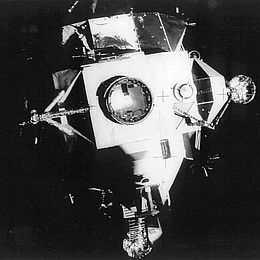
(Picture: NASA)
What did you feel about the incident of Apollo 13?
Edward F. Ladenburger: Lovell, Haise and Swigert were lucky to return safely to earth after the service module oxygen tank ruptured. They utilized the lunar module to accomplish the safe return. This was unexpected, and their return was cause for celebration. Their utilization of the porous plate sublimator to „wick“ off the heat generated by electronics helped with their control of the environment in the module. Yes, an example of collaboration of many engineering minds to plan the safe return.
When astronauts were in space with equipment you had responsibility for and did you get sleep well in the meantime?
Edward F. Ladenburger: All equipment had been tested, re-tested, and re-tested many times to develop confidence on reliability. The type of testing, test equipment, nature of the tests were all reviewed and critiqued many times by different people. However, in spite of this level of confidence, I was never very far from the „Red phone“ in the event something unexpected happened and Houston Command Center wanted conference with those who knew the equipment best. While confident the equipment was good, it was always appropriate to be constantly available in case of an „accident“.
I know you visited Star-City in Russia after many years when secrecy about project moon was over.
Edward F. Ladenburger: I had no compunction of conversing with the Cosmonaut. There wasn’t anything he could say that I didn’t already know. At that point there was no need to pretend. He was about the 126th Russian to go into space. He was more of a prima-donna to show off for foreign visitors. While I respected his accomplishment in traveling into space and returning safely, I was not overly impressed with him or their training facility.
And when you say that russia learned or spies a lot of you are there things that you could learn from USSR/Roskosmos?
Edward F. Ladenburger: In any relationship between major super-powers, there is, and always will be, considerable stealthy poking around to learn what the other fellow is doing or has done or is about to do and with what. Part of our intelligence effort was learning what they knew, which would tell us where they got the information. We did not follow the same technical process. For example, the USSR had huge rockets and could be extravagant on the payload. They chose to carry air as you breathe on earth to support their people. We, on the other hand chose to reduce the weight by using about 3 PSI of oxygen, which is all that is needed to maintain healthy breathing. So, we could use smaller lift-off rockets and/or carry other important payloads.
What do you think about the development today and in the future of space flight engineering? Are you optimistic about the development? Do we need more ambition today?
Edward F. Ladenburger: Future development of space flight engineering? We have extended the range of space exploration, looking to the future where other solar systems are being explored. This is currently beyond manned exploration and is therefore planned as robotic exploration. If it takes 50 or 100 years to travel from earth to a space destination, it does not lend itself to human exploration as on the moon. The farther one chooses to travel, the less chance for successful return. While there are still some enthusiastic scientists who would sign up for a one (1) way ride, it is not palatable situation. Therefore, more emphasis is needed on more sophisticated equipment to send on such long journeys and be able to be controlled from earth and send investigative information back to earth. There is considerable work being done along these paths. But, the cost is extremely high, and the information is returned a long time in the future. It is a balancing act on spending billions on investigative ventures of outer space that seem not to have payback anytime in the future, or spend billions on current problems within our country to help our citizens now and/or provide protection for other peoples of the earth that cannot protect themselves.
What about SpaceX and the vertical landing Falcon 9 Rockets?
Edward F. Ladenburger: There will always be wealthy people who have a hobby of fine-tuning rocketry or airplanes or deep sea submersibles just to show it can be done. This is not an advancement of space science or space exploration. It is true, that as more countries become adept at rocketry and electronics and wish to put their own satellite in orbit for communication, or spying, the atmosphere surronding the earth has become absolutely cluttered with junk. The laws attested to by major countries demands that only the country that put an item in space can collect it for garbage. Of course, just let it slowly re-enter the atmosphere and burn up. Course that will take YEARS. Meanwhile the atmosphere gets more cluttered.
Thank you very much for the conversation very nice to meet you!
Smithsonian Wall of Honor:
Apollo Portable Life Support System (PLSS) – pdf:
